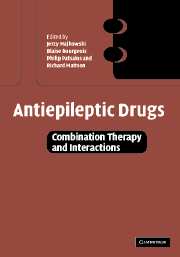Book contents
- Frontmatter
- Contents
- List of contributors
- Foreword
- Foreword
- Acknowledgements
- Part I Introduction
- Part II Pharmacokinetic interactions
- Part III Pharmacodynamic interactions
- Part IV Drug interactions in specific patient populations and special conditions
- 14 Antiepileptic drug interactions in children
- 15 Antiepileptic drug interactions in the elderly
- 16 Antiepileptic drug interactions in pregnancy
- 17 Antiepileptic drug interactions in handicapped and mentally retarded patients
- 18 Antiepileptic drugs and sex steroids
- 19 Antiepileptic drug interactions in patients requiring psychiatric drug treatment
- 20 Antiepileptic drugs in non-epileptic health conditions: possible interactions
- 21 Drug monitoring in combination therapy
- 22 Cognitive side-effects due to antiepileptic drug combinations and interactions
- Part V Conclusions and future perspectives
- Index
15 - Antiepileptic drug interactions in the elderly
from Part IV - Drug interactions in specific patient populations and special conditions
Published online by Cambridge University Press: 07 September 2009
- Frontmatter
- Contents
- List of contributors
- Foreword
- Foreword
- Acknowledgements
- Part I Introduction
- Part II Pharmacokinetic interactions
- Part III Pharmacodynamic interactions
- Part IV Drug interactions in specific patient populations and special conditions
- 14 Antiepileptic drug interactions in children
- 15 Antiepileptic drug interactions in the elderly
- 16 Antiepileptic drug interactions in pregnancy
- 17 Antiepileptic drug interactions in handicapped and mentally retarded patients
- 18 Antiepileptic drugs and sex steroids
- 19 Antiepileptic drug interactions in patients requiring psychiatric drug treatment
- 20 Antiepileptic drugs in non-epileptic health conditions: possible interactions
- 21 Drug monitoring in combination therapy
- 22 Cognitive side-effects due to antiepileptic drug combinations and interactions
- Part V Conclusions and future perspectives
- Index
Summary
Introduction
The elderly (≥65 years) are the fastest growing segment of the population in developed countries. In the USA, older adults presently comprise 13% of the population and are projected to increase to 20% within the next 20 years. Similar demographics exist for many European countries. With advancing age comes increasing morbidity, medication use, and adverse drug reactions. Over two-thirds of older adults have one or more chronic medical problems (Hoffman et al., 1996). As a consequence more elderly take medications than others and the elderly take more drugs per person. In the USA, almost 90% of community-dwelling elderly take one or more medications (Guay et al., 2003). Antiepileptic drugs (AEDs) are frequently prescribed in the elderly due to the high prevalence of AED-treatable neuropsychiatric disorders in this age group. For example, epilepsy is twice as common in those ≥65 years (1.5%) than in younger adults (Hauser, 1997). An estimated 1.6% of community-dwelling elderly take one or more AEDs (Nitz et al., 2000).
AED use is even greater among elderly nursing home residents. Based on two national surveys, approximately 10–11% of elderly nursing home residents take at least one AED and within this group 14–19% are on two or more AEDs including combinations known to interact (Schachter et al., 1998; Garrard et al., 2000).
Factors contributing to AED interactions in the elderly
There are several factors associated with AED therapy in the elderly that substantially increase the risk of clinically significant drug interactions.
Keywords
- Type
- Chapter
- Information
- Antiepileptic DrugsCombination Therapy and Interactions, pp. 273 - 293Publisher: Cambridge University PressPrint publication year: 2005
- 2
- Cited by

